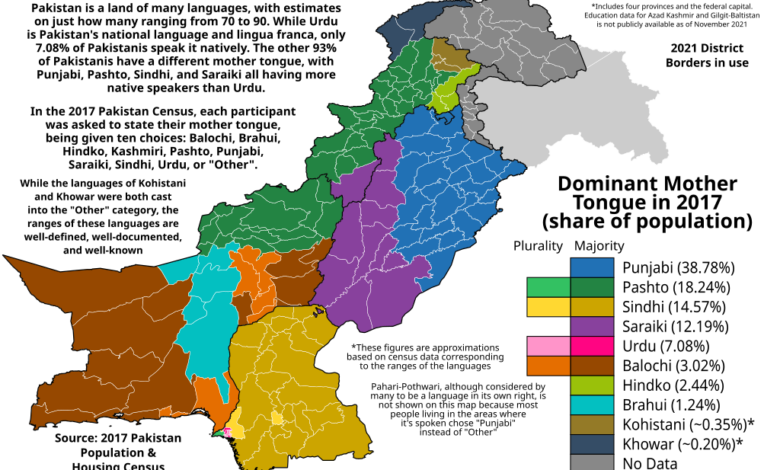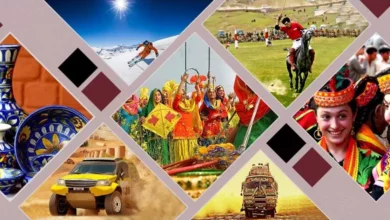
Pakistan is a linguistically diverse country, home to a wide array of languages that reflect its rich cultural heritage and ethnic plurality. The nation’s linguistic landscape is shaped by its historical roots, regional variations, and the coexistence of numerous ethnic groups. This blog post will delve into the major languages spoken in Pakistan, their significance, and the role they play in the lives of its people.
1. Urdu: The National Language
Overview: Urdu serves as the national language and is a symbol of national unity in Pakistan. It is widely spoken and understood across the country, bridging communication gaps among various ethnic groups.
History: Developed during the Mughal era, Urdu evolved from the interaction of Persian, Arabic, Turkish, and local Indian languages. It became prominent in literature and education during British colonial rule and was later adopted as the national language after the creation of Pakistan in 1947.
Usage: Urdu is the medium of instruction in schools and is used in government, media, and literature. It plays a crucial role in fostering a sense of identity among Pakistanis.
2. Punjabi: The Most Spoken Language
Overview: Punjabi is the most widely spoken language in Pakistan, primarily spoken in the Punjab province, which is the country’s most populous region.
History: The language has a rich literary history, with roots tracing back to ancient times. It incorporates elements from Persian, Arabic, and English due to the region’s historical interactions.
Cultural Significance: Punjabi culture is celebrated through folk music, dance, and literature. The language boasts a rich oral tradition and is known for its vibrant poetry and songs.
3. Sindhi: The Language of Sindh
Overview: Sindhi is primarily spoken in the Sindh province, where it is the official language. It has a significant presence in literature and education.
History: Sindhi has ancient origins, with historical texts dating back thousands of years. The language has evolved over time, absorbing influences from Arabic, Persian, and English.
Cultural Importance: Sindhi literature is renowned for its poetry and prose, with celebrated writers like Shah Abdul Latif Bhitai. The language is also an integral part of Sindhi identity and culture.
4. Pashto: The Language of the Khyber Pakhtunkhwa Province
Overview: Pashto is primarily spoken in Khyber Pakhtunkhwa and Balochistan provinces. It is one of the two official languages of the province of Khyber Pakhtunkhwa.
History: Pashto is an ancient language with roots in the Indo-Iranian language family. It has a rich oral tradition and a notable literary heritage, including works from famous poets like Khushal Khan Khattak.
Cultural Role: Pashto plays a vital role in the cultural identity of Pashtun communities. It is often associated with traditional music, dance, and storytelling.
5. Balochi: The Language of Balochistan
Overview: Balochi is primarily spoken in the Balochistan province, where it serves as the main language of the Baloch people.
History: Balochi has ancient roots and is part of the Iranian language family. It has been influenced by Persian, Arabic, and Urdu.
Cultural Significance: The language is an essential part of Baloch culture, with a rich tradition of oral poetry and folklore. Balochi literature reflects the history and struggles of the Baloch people.
6. Other Regional Languages and Dialects
In addition to the major languages mentioned above, Pakistan is home to several other regional languages and dialects, including:
- Saraiki: Spoken in southern Punjab, Saraiki has its own distinct culture and literature.
- Hindko: Primarily spoken in parts of Khyber Pakhtunkhwa and northern Punjab, Hindko has a rich oral tradition.
- English: While not a native language, English is widely used in government, education, and business, serving as a lingua franca among educated Pakistanis.
7. Conclusion
The linguistic diversity of Pakistan reflects the country’s complex cultural mosaic. Each language carries its own history, literature, and traditions, contributing to the rich tapestry of Pakistani society. Understanding the languages spoken in Pakistan is essential for appreciating its culture and identity, as they play a vital role in communication, education, and social cohesion. As the nation continues to evolve, the preservation and promotion of its linguistic heritage remain crucial for fostering unity and understanding among its diverse communities.



